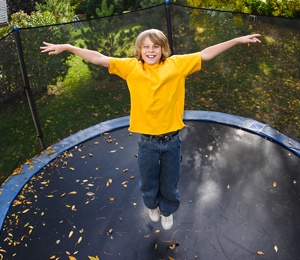 Now that spring is here, neighborhoods are starting to come back to life. More people are walking, kids are riding their bikes and scooters, and some have even started yard work.
Now that spring is here, neighborhoods are starting to come back to life. More people are walking, kids are riding their bikes and scooters, and some have even started yard work.
Another sign that spring has arrived is neighborhood kids playing on trampolines. Trampolines have become a popular addition to many backyards. Trampoline parks are also popping up in larger cities. While they’re fun and provide our kids with exercise, they can be dangerous if safety guidelines aren’t followed.
On the flip side, there are benefits of trampolines. Trampolines:
- Improve your balance;
- Firm and toned muscles;
- Offer a low-impact exercise;
- Provide a tremendous cardiovascular workout; and
- Get kids off video game systems, computers, and smartphones.
If you have a trampoline or are considering one for your kids, here are some things to remember.
1. Talk to your insurance agent.
Before spending money on a trampoline, talk to your independent insurance agent. They can tell you if your current homeowner’s policy covers it.
2. Avoid letting young kids use it.
The American Academy of Orthopedic Surgeons recommends limiting access to kids aged six and under. Remove ladders and other things around the trampoline that would allow them to get on it by themselves.
3. Adult supervision.
No matter how old your kids are, they always need adult supervision. The age and maturity of your child may determine how much supervision is necessary. Always be aware of what’s happening on your property, especially if you have a swing set, trampoline, or swimming pool. Occasional glances can ensure rules are being followed and kids are safe.
4. Establish written rules.
My neighbor used to have a trampoline. Before my daughters could use it, they had to agree to the written rules. Written rules can:
- Limit the number of kids on the trampoline;
- Prohibit food or drink;
- Enforce no rough housing; and
- Enforce no aerobatics or risky tricks (i.e., somersaults, backflips).
5. Talk to other parents.
If neighborhood kids are using your trampoline, talk to their parents to make sure it’s okay with them.
6. Attach safety devices.
Purchase and attach quality padding to the frame and springs of the trampoline, and use quality netting around the perimeter to help prevent kids from falling off. Avoid buying cheap protective gear.
7. Place it on a flat, clear surface.
When setting up your trampoline, ensure it’s on a flat surface away from trees, fences, swing sets, swimming pools, etc. Place it on sand or bark chips that can provide some cushioning. Never place it on a concrete surface.
8. Periodic inspections are necessary.
Periodically inspect the trampoline, looking for tears, broken springs, loose bolts, and worn safety pads and netting. The different weather patterns in the Midwest can cause the equipment to deteriorate.
Additional Resources
Trampoline Safety
Installing a safety net on your trampoline
Set up trampoline enclosure
Do you have any suggestions or information you’d like to share? I’d love to hear from you. Please share them in the box below.
This article is intended for general educational and illustrative purposes only and should not be construed to communicate legal or professional advice. Further, this article is not an offer to sell insurance. Please consult with your licensed insurance agent for specific coverage details and your insurance eligibility. All policies are subject to the terms, conditions, limitations, definitions, and exclusions contained therein.





